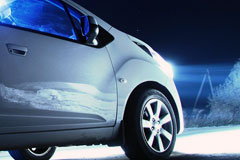When Should Headlamps Be Used? - Vol.339
Sometimes, it's easy to be unsure about whether or not you should be driving with your headlamps on. Maybe you see some cars using them and some cars not, or the weather just won't make up its mind. It can be even more confusing if you travel a lot, as laws and regulations can be different depending on where you are. While the most important thing to consider is safety, abiding by the laws in your area is a good way to ensure you will be able to continue driving in the first place. With that in mind, there is a great general rule to remember about when to use your headlamps:

The General Rule: Always use headlamps when in low-visibility conditions
The point of the headlamps is to cast those big bright headlights all over your field of vision to illuminate otherwise difficult to see roadways and potential hazards, pedestrians, cyclists, or even other cars.
Here is a breakdown of the situations in which you will definitely want to click to lights on:
At night: Use the high beam, or 'brights', when traveling on dark roads without traffic in front of you. If you are behind someone or there is a car coming the other directing in front of you, switch to low beams to avoid dazzling them (as this can be very dangerous). If a car coming towards you us using their high beams, do not switch yours on to seek revenge; vindictiveness is not worth the danger of hurting or killing anybody in a dangerous accident. When making turns, switch to low beam to avoid cutting across someone's field of vision that may be traveling the other way.
In overcast weather: A lot of people don't know this, but overcast weather in the daytime can be one of the most dangerous times to drive. The disbursement of light from the clouds above tricks motorists into thinking they have more light than they do, when in reality it is quite dark. This overconfidence in conditions of low visibility can cause accidents that are otherwise easily avoidable. Try to keep your low beams on when driving in cloudy weather. Remember: you always want to be as visible as possible without making the world invisible to someone you've just blinded!
In fog: Avoid using your high beams in foggy weather, as the fog will simply reflect the light back into your field of vision and dazzle you. Use a combination of low beam and fog lights, as this will greatly increase your range of vision and visibility under these conditions.
In precipitation: Needless to say, if it's raining or snowing then it is probably overcast. For the same reasons as stated above, it is important to use your headlamps during these conditions to make yourself visible to other people and to increase your range of vision. When it's raining or snowing, the roads can be slippery and you will need more braking time to come to a full stop, so the increased vision goes a long way towards improving the safety of everyone on the road.
If you have automatic headlamps, much of this will not be a problem for you. However, you may need to keep in mind that automatic headlamps have limitations that will require you to manually toggle your headlamps on or off depending on the situation. For example, many automatic headlamp systems do not turn on immediately in cases of sudden darkness, such as entering a tunnel. Use your best judgment to think ahead for situations like this and avoid causing any safety hazards.